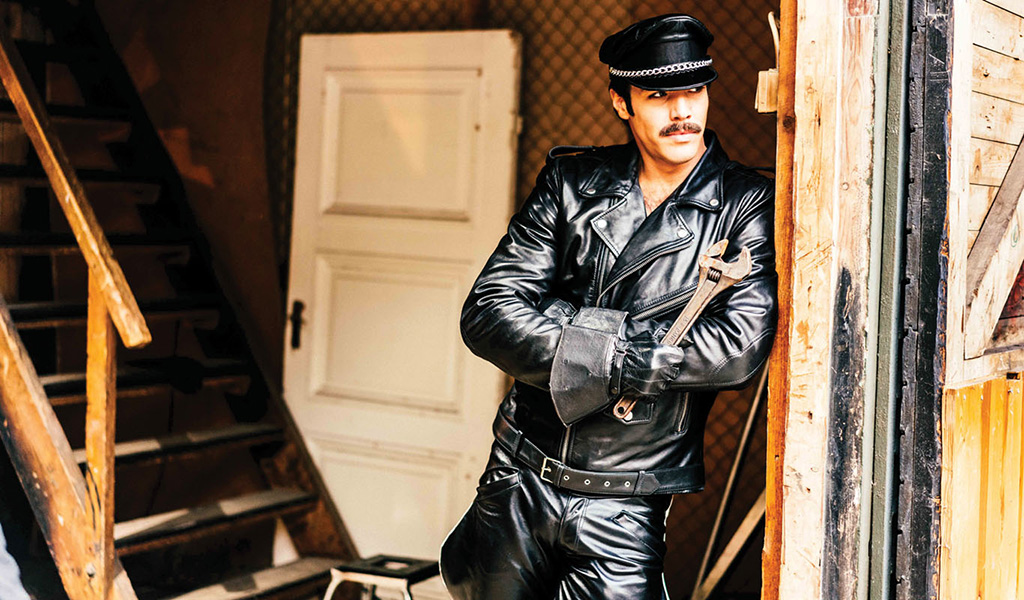Review: Tom of Finland
Sibling rivalry and gay sexual liberation fuel an iconic artist's fire in "Tom of Finland"

Entering the erotically charged world of Tom of Finland (★★★½), a viewer might expect to be piqued or titillated by the film’s dimly-lit, cruisy exploration of gay sexual liberty in post-war Europe. However, what comes as a surprise is the movie’s poignant depiction of sibling rivalry, between the Finnish artist Touko Laaksonen (Pekka Strang), and his younger sister, Kaija (Jessica Grabowsky).
Kaija, like her brother Touko (known as Tom), was a talented artist and illustrator, but, according to the excellent script by Aleksi Bardy and the film’s director Dome Karukoski, she lacked something that makes a good artist a great one. To put it bluntly, maybe she didn’t have the balls, both in terms of confidence, and as regards the male privilege that her brother enjoyed as a decorated ex-Army officer.
The movie loads an era’s worth of meaning into the arc of Touko’s career progress at the advertising agency where Kaija gets him a job alongside her as an illustrator. He quickly and quietly advances to management, while Kaija remains in the pool.
It’s merely a background plot to Karukoski’s decades-spanning biography of an artist whose influence on the culture of masculinity could hardly be measured, but the point is made. Avenues of opportunity opened to Touko, some that Kaija or any other woman at the time might not have accessed as freely. But then, Kaija, portrayed brilliantly by Grabowsky as a woman seething with ambition and uncertainty, also stands in her own way. Worse, she might have stood in the way of her gay brother, whom she calls “totally confused.”
Portrayed by Strang as a quick wit and quiet charmer, Touko isn’t confused. He is as brazen as the pictures he draws in his spare time of voluptuously muscular, well-endowed men, in and out of uniform, engaged in hot sex. At his job, he dares to infuse ad concepts and illustrations with an undercurrent of sensuality and eroticism.
Then, in his art, he’s clever enough to bring the approachability of advertising into his homoerotic drawings. Tom’s innovation is to draw his figures as provocatively as he pleased, but with the gleaming smiles and affable good looks of characters hawking coffee or soap.

The film makes clear, if any viewer wasn’t already aware, that Touko has the skills and vision to pull off this risqué marriage of wholesomeness and porn. Also clear is Touko’s preference in making the choice between art, which springs from his essence, and advertising, which he describes as “promoting the consumption of useless things by unethical means.”
Karukoski’s storytelling is largely visual. Several scenes play out wordlessly, shot in the noir-style of ’40s spy thrillers, of men in boots, hats, and overcoats cruising the dark. Revealing the secretive world of homosexuals in Helsinki and Berlin, the camera roves with Touko through red-tinted backroom bars and smoky private parlors. The action is furtive, and the sex onscreen is shot suggestively, but not at all graphically.
Guided to the underground scene by his army captain Alijoki (a wonderful Taisto Oksanen), Touko finds a home there. For the curious or uninitiated, the film itself will serve as a guide to closeted gay culture before men were “gay,” before Stonewall, before Tom of Finland.

Where the film missteps is in its muddled portrayal of the world after Tom’s art lands in gay America like a tidal wave. As Touko is tossed from his ’50s European milieu to swinging ’70s San Francisco and L.A., the movie piles on period signifiers and unconvincing old-age makeup, but doesn’t wring much story out of the popular artist’s immediate influence on the self-image of men-loving men.
Similarly, the plot involving Touko and Kaija’s romantic rivalry over a roommate, Veli (Lauri Tilkanen, in a warmly engaging performance) unspools as a conventional and murky aside to the main show, which always is Touko, the man who became Tom.
Tom of Finland became an icon creating enduring images of maleness, including his signature leatherman character “Kake,” who in the film appears to the artist as a muse in the well-cast guise of Swedish actor and former figure skater Niklas Hogner. Karukoski’s film captures the spark of inspiration that moves Tom to draw whenever he sees, or imagines, a man like Kake. More delicately, the film brings to life the desire that lit the artist’s genius, until he’d filled the entire world with leather gods and muscle studs.
Tom of Finland is rated R, and opens at the Landmark E Street Cinema on Friday, December 8. Visit landmarktheatres.com.
Support Metro Weekly’s Journalism
These are challenging times for news organizations. And yet it’s crucial we stay active and provide vital resources and information to both our local readers and the world. So won’t you please take a moment and consider supporting Metro Weekly with a membership? For as little as $5 a month, you can help ensure Metro Weekly magazine and MetroWeekly.com remain free, viable resources as we provide the best, most diverse, culturally-resonant LGBTQ coverage in both the D.C. region and around the world. Memberships come with exclusive perks and discounts, your own personal digital delivery of each week’s magazine (and an archive), access to our Member's Lounge when it launches this fall, and exclusive members-only items like Metro Weekly Membership Mugs and Tote Bags! Check out all our membership levels here and please join us today!



















You must be logged in to post a comment.